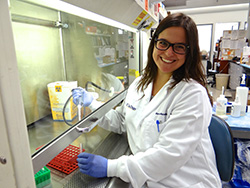A team from the University of Montreal Hospital Research Centre has developed an innovative technique to identify the cells that hide HIV in patients on antiretroviral therapy (ART).
Persistent reservoirs of HIV not cleared by ART represent the main barrier to a cure.
 Dr. Marta Massanella"We can wake up the virus and then find the rare cells that have been hiding it at very low numbers, a limit of one cell in a million,” lead author Dr. Daniel Kaufmann said in a press release on the findings, featured in the September issue of Cell Host & Microbe.
Dr. Marta Massanella"We can wake up the virus and then find the rare cells that have been hiding it at very low numbers, a limit of one cell in a million,” lead author Dr. Daniel Kaufmann said in a press release on the findings, featured in the September issue of Cell Host & Microbe.
amfAR-funded grantees Drs. Marta Massanella, Rémi Fromentin, Nicolas Chomont, and Andrés Finzi were coauthors on the study.
“This is an unprecedented level of accuracy, which opens the door to individualized monitoring of HIV-positive patients and could facilitate the development of personalized treatments," Kaufmann said.
HIV replicates primarily in CD4+ T lymphocytes, a type of white blood cell. While drugs are generally successful in controlling viral load in infected individuals, some viruses remain “hidden” for years and can reemerge if patients stop treatment.
With his team, Kaufmann developed a technique for detecting HIV reservoirs, an approach likened to taking a photo of each individual cell hiding the virus. It is considered 1,000 times more accurate than current technologies.
 Dr. Nicolas ChomontOnce the reservoirs are found, the researchers can use a “shock and kill strategy,” shocking the dormant HIV so that drugs or the immune system can kill it.
Dr. Nicolas ChomontOnce the reservoirs are found, the researchers can use a “shock and kill strategy,” shocking the dormant HIV so that drugs or the immune system can kill it.
“These cells are extremely rare and hard to find,” Chomont said. “Using this method we can actually see them, and if we can see them we can study them. If we know where they are and what they look like, that will give us an edge in eliminating them.
“We can apply this technology to study tissues as well. We know the virus hides in the gut, the brain, and the lymph nodes.”
For the study, researchers analyzed the blood of 30 patients infected with HIV, both before the patients started ART and after, and found the virus in CD4+ T lymphocytes in almost all of them.
They then tested two latency-reversing drugs: bryostatin and a derivative of ingenol, which were developed to fight cancer but may be useful in curing HIV. They found that the two drugs wake up different populations of CD4+ T lymphocytes, thus stirring different reservoirs. Bryostatin induced virus expression mostly from effector memory T cells, while the ingenol derivative acted across a broader range of reservoir cell types.
Kaufmann’s research also revealed that the virus hides in different places in different patients, which means treatment will have to be adjusted depending on its specific hiding places in each case.
“To minimize the virus pools, we will have to assess patients and tailor ‘shock and kill’ therapies to their profiles,” he said.
Massanella said the technique represents an advantageous tool for the specific and sensitive detection of latently infected cells.
“It allows not only a precise quantification of the size of the HIV reservoir but also enables a phenotypic characterization of cells harboring HIV,” she said. “Therefore, this will allow the development of targeted HIV cure strategies and vaccines eliciting immune responses capable of eliminating specifically HIV latently infected cells.”
The researchers are planning to evaluate the effectiveness of new drugs to awaken similar virus reservoirs in monkeys and determine where the virus is hidden. The hope is to begin clinical trials in a few years.